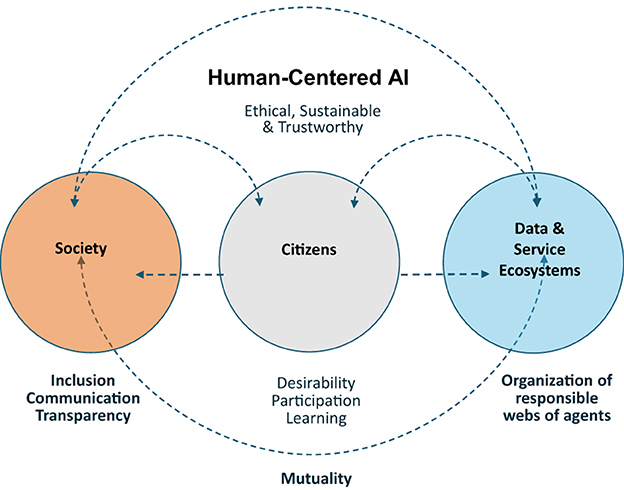Why AI Doesn't Learn And How This Impacts Its Responsible Application

Table of Contents
The Nature of AI "Learning": A Statistical Approach, Not True Understanding
The term "AI learning" often evokes images of sentient machines acquiring knowledge like humans. However, the reality is far more nuanced. AI learning, particularly within the realm of machine learning, is primarily a statistical process. Machine learning algorithms, at their core, are sophisticated pattern recognition tools. They identify correlations within massive datasets to make predictions and classifications. This is a far cry from the genuine understanding, contextual awareness, and generalizability that characterize human learning.
- AI systems learn through identifying correlations, not causality. They can excel at predicting outcomes based on statistical relationships but often lack the ability to grasp the underlying causes.
- AI models are trained on specific data, limiting their applicability to unseen situations. An AI trained to identify cats in photographs might fail to recognize a cat in a video or a drawing, highlighting its limited generalizability.
- Deep learning networks, while powerful, operate as complex statistical machines, not conscious learners. Their success stems from their ability to extract intricate patterns from data, not from any form of conscious understanding.
- The difference between supervised, unsupervised, and reinforcement learning highlights inherent limitations. Supervised learning relies on labeled data, limiting its ability to handle novel situations. Unsupervised learning struggles with the inherent ambiguity of unlabeled data. Even reinforcement learning, while adaptive, is still fundamentally driven by reward signals and lacks genuine understanding of its environment.
Data Limitations and Biases: The Foundation of AI's Flaws
The quality and nature of the data used to train AI systems significantly impact their performance and ethical implications. The critical concept here is AI bias. Because AI models learn from data, any biases present in the training data will inevitably be reflected in the AI's outputs. This "garbage in, garbage out" principle applies forcefully to AI systems.
- Biased data leads to biased AI models, perpetuating societal inequalities. For example, facial recognition systems trained on predominantly white faces often perform poorly on individuals with darker skin tones.
- The "garbage in, garbage out" principle applies strongly to AI. If the data used to train an AI system is flawed, incomplete, or biased, the resulting AI system will be flawed, incomplete, or biased.
- Examples of AI bias are prevalent in various applications. Loan applications might unfairly discriminate against certain demographics, or AI-powered hiring tools could exhibit gender or racial biases.
- Data curation, cleaning, and augmentation are crucial for responsible AI development. Addressing data limitations and biases requires meticulous attention to data quality and diversity throughout the AI lifecycle.
The Impact of AI's "Non-Learning" on Responsible Application
The fact that AI systems don't truly "learn" or understand has profound implications for responsible AI application. It necessitates a heightened focus on AI safety, accountability, and ethical considerations.
- The potential for unintended consequences is significant due to AI's lack of genuine understanding. An AI system might make a seemingly logical decision based on statistical correlations that, in reality, lead to harmful outcomes.
- Assigning responsibility when AI systems make mistakes is challenging. Determining accountability when an autonomous vehicle causes an accident, for example, raises complex legal and ethical questions.
- Explainable AI (XAI) is vital to understand and debug AI decisions. Transparency in AI algorithms is crucial for building trust and identifying potential biases or errors.
- Regulations and ethical guidelines are essential to govern AI development and deployment. Responsible AI development requires a robust framework that prioritizes safety, fairness, and accountability.
Mitigating Risks: Steps Towards Responsible AI
Addressing the challenges posed by AI's limitations requires a proactive approach. Organizations and developers must prioritize ethical considerations throughout the AI lifecycle.
- Implement rigorous testing and validation procedures for AI systems. Thorough testing can help identify and mitigate biases and errors before deployment.
- Employ techniques to detect and mitigate bias in AI models. This involves careful data curation, algorithm design, and ongoing monitoring of AI performance.
- Promote transparency and explainability in AI decision-making processes. Explainable AI (XAI) allows for greater scrutiny and accountability.
- Establish ethical review boards for AI projects. Independent oversight can help ensure that AI systems are developed and deployed responsibly.
Conclusion
AI's "learning" is not equivalent to human learning. It's a statistical process, deeply reliant on data and algorithms. This difference necessitates a responsible approach to AI development and application, demanding careful consideration of data quality, bias mitigation, transparency, and accountability. To foster a future where AI serves humanity ethically, we must move beyond simplistic notions of AI "learning" and embrace a more nuanced understanding of its capabilities and limitations. Further exploration of AI ethics and active participation in discussions about responsible AI practices are crucial steps in ensuring a beneficial future with AI. Let's work together to promote responsible AI development and application.

Featured Posts
-
 New Yorks 3 C Temperature Drop Canadian Wildfire Smokes Impact On Air Quality
May 31, 2025
New Yorks 3 C Temperature Drop Canadian Wildfire Smokes Impact On Air Quality
May 31, 2025 -
 Local Man Matthew Sexton Convicted On Animal Pornography Charges
May 31, 2025
Local Man Matthew Sexton Convicted On Animal Pornography Charges
May 31, 2025 -
 Mlb Roll Call Chase Lee Pitches Scoreless Inning In Return May 12 2025
May 31, 2025
Mlb Roll Call Chase Lee Pitches Scoreless Inning In Return May 12 2025
May 31, 2025 -
 Book Now And Save 30 Off Lavish Spring Hotels
May 31, 2025
Book Now And Save 30 Off Lavish Spring Hotels
May 31, 2025 -
 How To Watch Giro D Italia Online For Free A Complete Guide
May 31, 2025
How To Watch Giro D Italia Online For Free A Complete Guide
May 31, 2025
